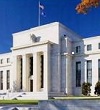By Pam Martens and Russ Martens: February 26, 2020 ~
Each year the Federal Reserve comes up with a hypothetical, severely adverse economic scenario against which it evaluates the ability of Wall Street’s mega banks to weather the storm. Called “stress tests,” this year’s severely adverse scenario features a severe global recession, unemployment of 10 percent, elevated stress in corporate debt markets and commercial real estate, along with a bank’s major counterparty defaulting if it has significant derivatives trading exposures. The stress test results are typically disclosed in June by the Fed with an immediate announcement by the banks (that get the green light from the Fed) about how many billions of dollars they plan to spend on stock buybacks and dividend increases to artificially boost their share prices.
What the Federal Reserve has not planned for in its stress test is a global recession (which was looking entirely likely prior to the coronavirus outbreak) on top of a massive supply chain disruption because of a spreading virus that shuts down factories, making it impossible to supply finished goods. What the Federal Reserve has also not tested in its stress tests is a retrenchment on spending by consumers because they are afraid to go on vacation or to malls or movie theaters or other public venues. In the U.S., consumer spending represents two-thirds of GDP.
We have long said that the Fed’s stress tests were nothing more than an illusion. (See related articles below.) Now the chickens are coming home to roost. The mega banks on Wall Street and their insurance company derivative counterparties continued to bleed out capital yesterday, with most down 8 to 10 percent over the two-day period. And that’s just on the possibility that the coronavirus will continue to spread.
This week has not been one of America’s finest hours. On Monday President Donald Trump Tweeted that the “Coronavirus is very much under control in the USA.” And while offering no sympathy to the families of the more than 2700 people who have died from the virus around the globe, Trump threw in that the “Stock Market starting to look very good to me!” The stock market, as measured by the Dow Jones Industrial Average, fell 1,031.61 points on Monday when the President issued his Tweet, and dropped another 879 points the following day.
As we warned in June of last year, Presidents who relentlessly tie their success to the success of rising stock prices are courting disaster.
Adding to questions about the accuracy of the President’s Tweet on the coronavirus on Monday, on Tuesday Nancy Messonnier, Director of the CDC’s National Center for Immunization and Respiratory Diseases, told reporters that the CDC was preparing for community-spread of the virus in the U.S. over the near term, appearing to contradict the President’s sunny assessment on Monday.
The President Tweeted this morning that he has called a press conference for 6 p.m. today at the White House and will have “CDC representatives, and others” present.
It is simply common sense that the virus should be expected to spread in the United States. It has already affected almost 81,000 people worldwide with more than 2700 deaths. And while the original epicenter was in China, there are now growing outbreaks in South Korea, Iran, Italy, Afghanistan, and Kuwait. Likely as a result of the spread of the virus in Italy, where at least 325 people have been infected and whole towns locked down, new cases are also being reported across Europe – in Austria, Croatia, France, Germany, Greece, Spain and Switzerland. Some of the U.S. business travelers to these countries who have returned to the United States are likely carriers of the virus, whose respiratory symptoms may not occur for as long as two weeks, or not at all. Everyone that an infected person has come in contact with since their return to the U.S. is a potential new carrier of the virus.
Related Articles:
Three Federal Studies Show Fed’s Stress Tests of Big Banks Are Just a Placebo
These Charts Show the Fed’s Stress Tests as a Dangerous Illusion



